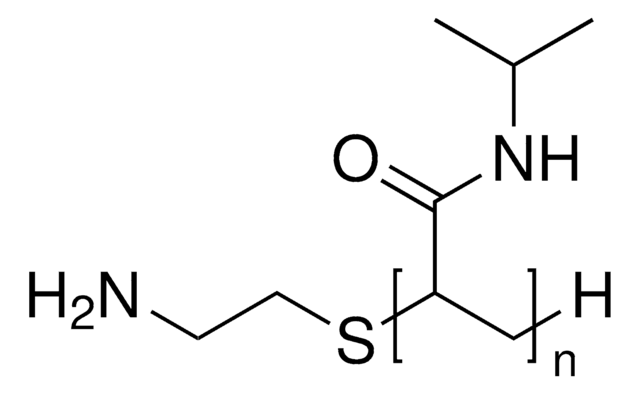PNIPAM is soluble in organic solvents, such as chloroform, acetone, methanol, and various other alcohols. It is also soluble in water, as long as the solution is kept reasonably cold. Please see the link below to review additional information regarding this compound:
https://www.sigmaaldrich.com/US/en/technical-documents/technical-article/materials-science-and-engineering/polymer-synthesis/poly-n-isopropylacrylamide
추천 제품
애플리케이션
Poly(N-isopropyl acrylamide) (PolyNIPAM) is a stimuli-responsive polymer[1]. This product features low polydispersity (PDI), which typically leads to better reproducibility in applications, and a terminal N-hydroxysuccinimide (NHS) functional group, allowing for rapid conjugation of biomolecules, small molecules, or other polymers. PolyNIPAM has been used in development of a variety of thermosensitive coated micro/nano materials, including thermoresponsive polymeric drug delivery systems[2][3].
Storage Class Code
11 - Combustible Solids
WGK
WGK 3
Flash Point (°F)
Not applicable
Flash Point (°C)
Not applicable
가장 최신 버전 중 하나를 선택하세요:
Avraham Halperin et al.
Langmuir : the ACS journal of surfaces and colloids, 28(48), 16623-16637 (2012-11-06)
Thermoresponsive tissue culture substrates based on PNIPAM brushes are used to harvest confluent cell sheets for tissue engineering. The prospect of clinical use imposes the utilization of culture medium free of bovine serum, thus suggesting conjugation with adhesion peptides containing
Umut Atakan Gurkan et al.
Advanced healthcare materials, 1(5), 661-668 (2012-11-28)
Stimuli responsive, smart interface materials are integrated with microfluidic technologies creating new functions for a broad range of biological and clinical applications by controlling the material and cell interactions. Local capture and on-demand local release of cells are demonstrated with
A C C Rotzetter et al.
Advanced materials (Deerfield Beach, Fla.), 24(39), 5352-5356 (2012-08-31)
Buildings can be effectively cooled by a bioinspired sweating-like action based on thermoresponsive hydrogels (PNIPAM), which press out their stored water when exceeding the lower critical solution temperature. The surface temperature is reduced by 15 °C compared to that of
Shahrzad Rayatpisheh et al.
Macromolecular bioscience, 12(7), 937-945 (2012-04-27)
A new method for ultrathin grafting of pNIPAm on PDMS surfaces is introduced that employs plasma activation of the surface followed by thermal polymerization. This method is optimized for human primary SMC attachment and subsequent intact cell sheet detachment by
Aniket S Wadajkar et al.
Acta biomaterialia, 8(8), 2996-3004 (2012-05-09)
New magnetic-based core-shell particles (MBCSPs) were developed to target skin cancer cells while delivering chemotherapeutic drugs in a controlled fashion. MBCSPs consist of a thermo-responsive shell of poly(N-isopropylacrylamide-acrylamide-allylamine) and a core of poly(lactic-co-glycolic acid) (PLGA) embedded with magnetite nanoparticles. To
문서
Professor Mitsuhiro Ebara provides insights on several types of smart nanofiber mesh systems that have been explored for different drug delivery purposes.
-
Hi, What is a good solvent for this chemical?
1 답변-
도움이 되었습니까?
-
활성 필터
자사의 과학자팀은 생명 과학, 재료 과학, 화학 합성, 크로마토그래피, 분석 및 기타 많은 영역을 포함한 모든 과학 분야에 경험이 있습니다..
고객지원팀으로 연락바랍니다.







